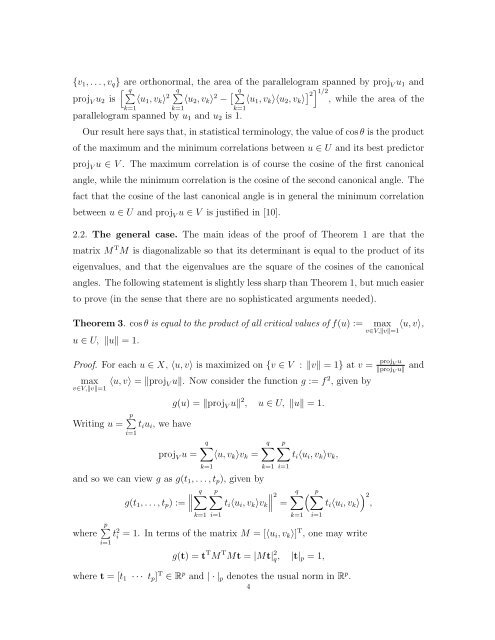on angles between subspaces of inner product spaces - FMIPA ...
on angles between subspaces of inner product spaces - FMIPA ...
on angles between subspaces of inner product spaces - FMIPA ...
Create successful ePaper yourself
Turn your PDF publications into a flip-book with our unique Google optimized e-Paper software.
{v1, . . . , vq} are orth<strong>on</strong>ormal, the area <strong>of</strong> the parallelogram spanned by projV u1 and<br />
� q�<br />
q� 2 projV u2 is 〈u1, vk〉 〈u2, vk〉 2 � q�<br />
− 〈u1, vk〉〈u2, vk〉 �2 �1/2 , while the area <strong>of</strong> the<br />
k=1<br />
k=1<br />
k=1<br />
parallelogram spanned by u1 and u2 is 1.<br />
Our result here says that, in statistical terminology, the value <strong>of</strong> cos θ is the <strong>product</strong><br />
<strong>of</strong> the maximum and the minimum correlati<strong>on</strong>s <strong>between</strong> u ∈ U and its best predictor<br />
proj V u ∈ V . The maximum correlati<strong>on</strong> is <strong>of</strong> course the cosine <strong>of</strong> the first can<strong>on</strong>ical<br />
angle, while the minimum correlati<strong>on</strong> is the cosine <strong>of</strong> the sec<strong>on</strong>d can<strong>on</strong>ical angle. The<br />
fact that the cosine <strong>of</strong> the last can<strong>on</strong>ical angle is in general the minimum correlati<strong>on</strong><br />
<strong>between</strong> u ∈ U and proj V u ∈ V is justified in [10].<br />
2.2. The general case. The main ideas <strong>of</strong> the pro<strong>of</strong> <strong>of</strong> Theorem 1 are that the<br />
matrix M T M is diag<strong>on</strong>alizable so that its determinant is equal to the <strong>product</strong> <strong>of</strong> its<br />
eigenvalues, and that the eigenvalues are the square <strong>of</strong> the cosines <strong>of</strong> the can<strong>on</strong>ical<br />
<strong>angles</strong>. The following statement is slightly less sharp than Theorem 1, but much easier<br />
to prove (in the sense that there are no sophisticated arguments needed).<br />
Theorem 3. cos θ is equal to the <strong>product</strong> <strong>of</strong> all critical values <strong>of</strong> f(u) := max 〈u, v〉,<br />
v∈V,�v�=1<br />
u ∈ U, �u� = 1.<br />
Pro<strong>of</strong>. For each u ∈ X, 〈u, v〉 is maximized <strong>on</strong> {v ∈ V : �v� = 1} at v = projV u<br />
�projV u� and<br />
max 〈u, v〉 = �projV u�. Now c<strong>on</strong>sider the functi<strong>on</strong> g := f<br />
v∈V,�v�=1<br />
2 , given by<br />
g(u) = �projV u� 2 , u ∈ U, �u� = 1.<br />
Writing u = p�<br />
tiui, we have<br />
i=1<br />
proj V u =<br />
q�<br />
〈u, vk〉vk =<br />
k=1<br />
q�<br />
k=1<br />
and so we can view g as g(t1, . . . , tp), given by<br />
� q� p� �<br />
�<br />
�<br />
g(t1, . . . , tp) := � ti〈ui, vk〉vk<br />
where p�<br />
k=1<br />
i=1<br />
� 2<br />
p�<br />
ti〈ui, vk〉vk,<br />
i=1<br />
=<br />
q� � p � �2 ti〈ui, vk〉 ,<br />
t<br />
i=1<br />
2 i = 1. In terms <strong>of</strong> the matrix M = [〈ui, vk〉] T , <strong>on</strong>e may write<br />
k=1<br />
i=1<br />
g(t) = t T M T Mt = |Mt| 2 q, |t|p = 1,<br />
where t = [t1 · · · tp] T ∈ R p and | · |p denotes the usual norm in R p .<br />
4


